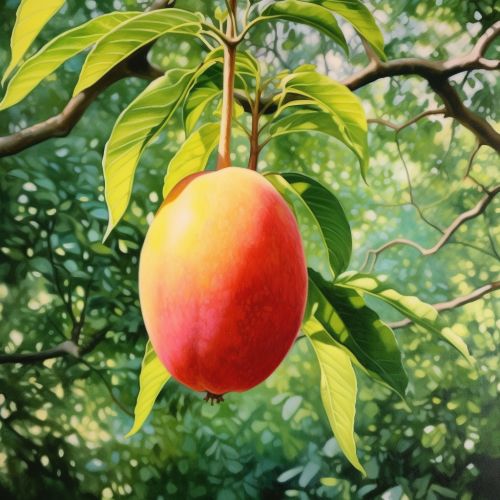Mango
Introduction
The Mango is a tropical fruit belonging to the drupe family. This means it has a single large seed or stone in the middle. Sometimes called the "king of fruits," it is one of the most widely cultivated fruits of the tropical world.
Description
Mangoes are juicy fruits that grow in many shapes and sizes, but are often oval or round. The skin of a ripe mango is typically golden yellow, but can also be green, red, or orange. The flesh, which is eaten, is orange and has a soft texture when the mango is ripe. The flavor is sweet and tart, with some varieties having a slight creamy texture.
Classification and Nomenclature
The mango is a member of the Anacardiaceae family, which also includes poison ivy and poison oak. The scientific name of the mango is Mangifera indica, which translates to "mango-bearing plant from India." The name "mango" comes from the Malayalam word māṅṅa via Portuguese.
History
The mango is native to South Asia, with the majority of species found in India. It has been cultivated in this region for over 4,000 years and reached East Asia between the 5th and 4th centuries BCE. By the 10th century CE, it had been transported to East Africa and the Middle East.
Cultivation and Production
Mangoes are grown in tropical and subtropical climates worldwide. They need a frost-free climate, and plenty of sunlight to grow properly. The trees are long-lived, as some specimens still fruit after 300 years. In deep soil, the taproot descends to a depth of 6 m, with profuse, wide-spreading feeder roots and anchor roots penetrating deeply into the soil.
India is the largest producer of mangoes globally, followed by Thailand, China, Indonesia, and Pakistan. In these regions, mangoes are harvested year-round, but the majority of the crop comes to market in the spring and early summer.
Varieties
There are hundreds of mango varieties worldwide. In India alone, there are over 280 types, including 'Alphonso', 'Dashehari', 'Kesar', and 'Langra'. Other popular varieties include 'Tommy Atkins', 'Ataulfo', 'Kent', and 'Haden', which are widely available in grocery stores in the United States.
Nutritional Value
Mangoes are rich in vitamins C and A and are a good source of dietary fiber. They also contain vitamin E, B6, and minerals like potassium, calcium, and iron. The antioxidants in mangoes are known to provide various health benefits.
Uses
Mangoes are used in a wide variety of dishes and culinary applications. They can be eaten raw, or used in cooking, baking, and in beverages like smoothies and cocktails. In addition, mangoes are used in the production of jams, jellies, and preserves, as well as in pickling.
Cultural Significance
In many cultures, the mango is a symbol of wealth, prosperity, and love. In India, mango leaves are used in wedding ceremonies to ensure the couple remains fertile. The mango tree also plays a central role in Buddhism, as it is often considered a sacred tree.
Conservation and Threats
Mango cultivation faces several challenges, including climate change, pests, and diseases. The mango tree is susceptible to a number of fungal diseases, including anthracnose, which can cause significant crop loss. Efforts are being made to breed disease-resistant varieties and to manage pests more sustainably.
See Also


